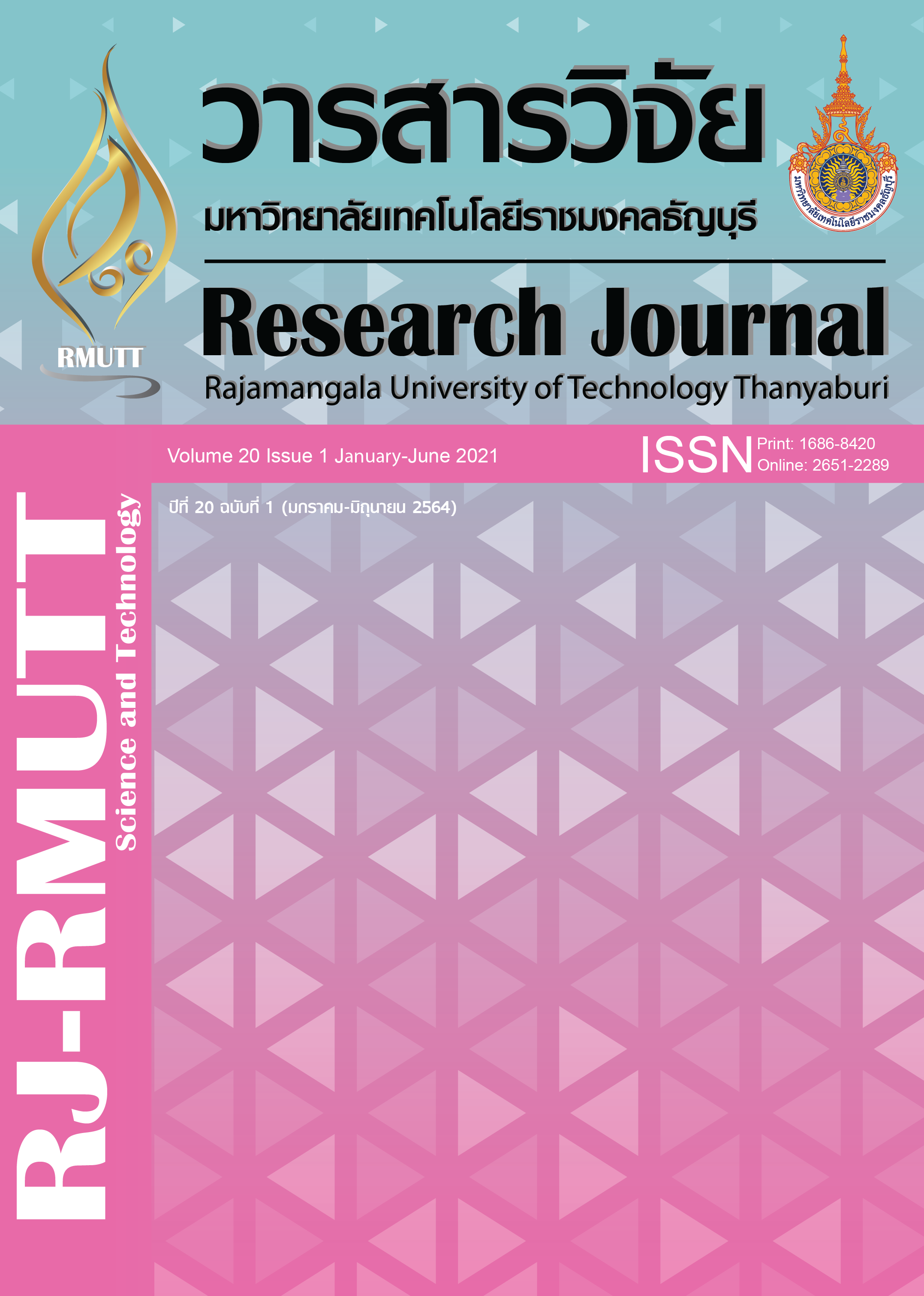Effect of Packaging Types on Quality of Dried Lotus Stamens
Main Article Content
Abstract
Dried lotus stamen was placed in different types of plastic bag including polypropylene (PP bag), PP bag with a moisture absorber (PP bag+MA), vacuum bag and aluminum foil zipper bag (AF bag) to maintain quality of dried lotus stamen. All samples were moved to store at 30ºC for 6 months. The color, moisture, antioxidant activities, carotenoid and odor of dried lotus stamen were determined. The results showed that the visual quality for the lotus stamen inside the four types of bags decreased continuously throughout of the storage period. The lotus stamen packaged in both vacuum bag and AF bag significantly had a better color of L* (37.57 and 41.57), a* (18.69 and 17.92) and b* (33.96 and 29.33), moisture content (4.55% and 4.05%), antioxidant (37.61 and 33.14%) and carotenoid content (40.51 and
40.00 mg/L) than PP bag and PP bag+MA. It was found that on the six month of storage, the lotus stamen inside the vacuum and AF bags had normal odor. On the other hand, the acceptable of odor for the produced packaged in the PP bag and PP bag+MA were not different and were unacceptable after storage for five months because of lotus stamen were odorless. At the end of six month storage period, the lotus stamen packed in PP bag significantly had the lowest L*, antioxidant and carotenoid content. However, qualities of sample in vacuum bag and aluminum foil significantly had showed antioxidant and carotenoid content more than plastic bag PP. The lotus stamens are rich in antioxidant and carotenoid content which makes them healthy, nourishing and also important ingredient in the food industry.
Article Details

This work is licensed under a Creative Commons Attribution-NonCommercial-NoDerivatives 4.0 International License.
References
นันทวัน บุณยะประภัศสร. สมุนไพรไม้พื้นบ้าน (2). กรุงเทพฯ: บริษัท ประชาชน จำกัด. 2541.
ธิดารัตน์ จันทร์ดอน. บัวหลวง...สัญลักษณ์แห่งพระพุทธศาสนา [อินเตอร์เน็ต]. [สืบค้นเมื่อวันที่ 27 เม.ย. 2562]. จาก: https://bit.ly/39NH8iS
Jung HA, Kim JE, Chung HY, Choi JS. Antioxidant Principles of Nelumbo nucifera Stamens. Pharm Res. 2003;26(4):279-85.
Bhuvana S, Mahesh R, Begum VH. Effect of Nelumbo nucifera flowers on plasma lipids and glucose in young, middle-aged and aged rats. Pharmacology online. 2008;2:863-74.
Mukherjee PK, Saha K, Das J, Pal M, Saha BP. Studies on the anti-inflammatory activity of rhizomes of Nelumbo nucifera. Planta Med. 1997;63:367-9.
Ono Y, Hattori E, Fukaya Y, Imai S, Ohizumi Y. Anti-obesity effect of Nelumbo nucifera leaves extract in mice and rats. J Ethnopharmacology. 2006;106:238–44.
Kunanusorn P, Panthong A, Pittayanurak, P, Wanauppathamkul S, Nathasaend N, Reutrakul V. Acute and subchronic oral toxicity studies of Nelumbo nucifera stamens extract in rats. J Ethnopharmacology. 2011;134:789–95.
สุชาดา เลาหศิลป์สมจิตร์. การบรรจุภัณฑ์แอคทีฟสำหรับชาอบแห้ง. วารสารการเกษตรราชภัฎ. 2561;17(1):34-41.
Lee J. Green tea: flavor characteristics of a wide range of teas including brewing, processing, and storage variations and consumer acceptance of teas in three countries [Doctor’s thesis]. Kansas: Kansas State University; 2009.
รุ่งนภา วิสิฐอุดรการ. การประเมินอายุการเก็บรักษาของอาหาร [เอกสารคำสอนวิชาพัฒนาผลิตภัณฑ์]. กรุงเทพฯ: มหาวิทยาลัยเกษตรศาสตร์. 2540.
ปุ่น คงเจริญเกียรติ, สมพร คงเจริญเกียรติ. บรรจุภัณฑ์อาหาร. กรุงเทพฯ: หยี่เฮง; 2541.
มยุรี ภาคลำเจียก. ฟิล์มพลาสติกที่ใช้ในการบรรจุหีบห่ออาหารว่าง. วารสารพลาสติก. 2536;10(3): 72-5.
งามทิพย์ ภู่วโรดม. การบรรจุอาหาร (Food packaging). กรุงเทพฯ: เอส.พี.เอ็ม.; 2550.
Knack K, Christensen LP. Effect of packing materials and storage time on volatile compounds in tea processed from flowers of black elder (Sambucus nigra L.). Eur Food Res Technol. 2008;227:1259-73.
สุรัตน์วดี วงค์คลัง, เลอลักษณ์ เสถียรรัตน์, อรุณพร อิฐรัตน์. การศึกษาฤทธิ์ต้านอนุมูลอิสระของบัวหลวง. วารสารวิทยาศาสตร์เกษตร. 2557;45(2 พิเศษ):673-76.
บังอร วงศ์รัก, ศิริลักษณ์ ปิยสุวรรณ. ฤทธิ์การต้านอนุมูลอิสระของผักพื้นบ้าน [โครงการพิเศษปริญญาเภสัชศาสตรบัณฑิต]. กรุงเทพฯ: มหาวิทยาลัยมหิดล; 2549.
Kundu P, Anitha K, Ramani N. Feeding impact of the vegetable mite, Tetranychus neocaledonicus André (Acari: Tetranychidae) on Mentha Rotundifolia L. Int J Recent Sci Res. 2016;7(4):10406-9.
Dumbravă DG, Moldovan C, Raba D, Popa MV. Vitamin C. chlorophylls, carotenoids and xanthophylls content in some basil (Ocimum basilicum L.) and rosemary (Rosmarinus officinalis L.) leaves extracts. J Agroaliment Processes Technol. 2012;18(3):253–58.
Techavuthiporn C, Nakano K, Maezawa S. Prediction of ascorbic acid content in broccoli using a model equation of respiration. Postharvest Biol Technol. 2008;47:373-81.
Villanueva MJ, Tenorio MD, Sagardoy M, Redondo A, Saco MD. Physical, chemical histological and microbiological changes in fresh green asparagus (Asparagus officinalis L.) stored in modified atmosphere packaging. Food Chem. 2005;91:609-19.
Chew YL, Lim YY, Omal M, Khoo KS. Antioxidant activity of three edible seaweeds from two areas in South East Asia. J Food Sci Technol. 2008;41(6):1067-72.
Wu MJ, Wang L, Weng CY, Yen JH. Antioxidant activity of methanol extract of the lotus leaf (Nelumbo nucifera Gaertn.). Am J Chin Med. 2003;31:687-98.
Limwachiranon J, Huang H, Shi Z, Li Li Luo Z. Lotus flavonoids and phenolic acids: Health promotion and safe consumption dosages. Compr Rev Food Sci Food Saf. 2018;17:457-71.
More RS, Chaubal SS. Determination of stress and comparison by estimation of chlorophyll-a, b and carotenoid contents among plants growing along Mithi River, Mumbai. International Journal of Scientific & Engineering Research. 2017;8(1):1–8.
Klomsakul P, Pumjumpa D, Khunpratum S, Chalopagorn P. Determination of antioxidant property from some medicinal plant extracts from Thailand. Afr J Biotechnol. 2012;11(45):10322–7.
Dhir R, Harkess RL, Bi G. Physio- logical responses of Ivy Geranium “Beach” and “Butterfly” to heat stress. J Am Soc Hortic Sci. 2013;138(5):344–9.
บุษราคัม สิงห์ชัย, นิศา ตระกูลภักดี, สาวิตรี ทองลิ้ม. น้ำมันหอมระเหยจากเกสรบัวหลวงราชินี. วารสารวิทยาศาสตร์และเทคโนโลยี. 2560;25(1):27-34.


